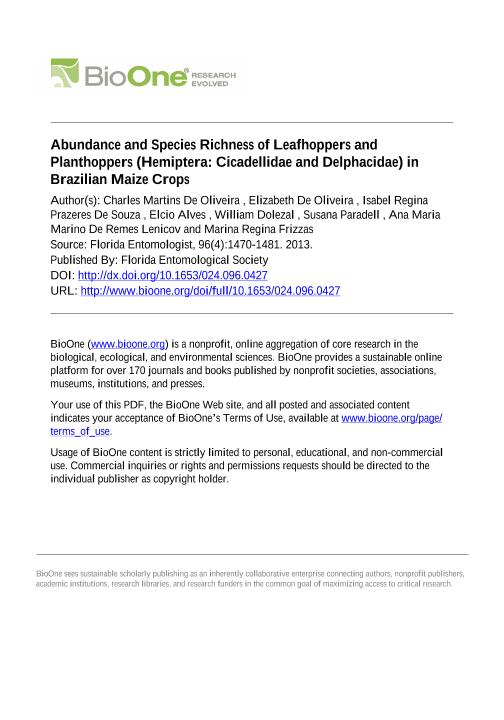Artículo
Insects in the Cicadellidae and Delphacidae families, common in grasses, are an important group of vectors of viruses and mollicutes, which cause diseases in several plant species. The goal of this study was to evaluate the abundance and species richness of Cicadellidae and Delphacidae and the presence of potential vectors of viruses and mollicutes in maize crops in Brazil. Insects were collected using sweep nets in maize crops in 48 counties of 8 states, distributed in 4 regions of Brazil in the yr 2005, 2006 and 2007, with a total of 198 samples. The collected material was screened, and the leafhoppers and planthoppers were identified at the species level. A total of 4233 Cicadellidae specimens, including 30 species, and 205 Delphacidae specimens, including 9 species, were collected. The most abundant species was Dalbulus maidis (Delong & Wolcott) representing 90.1% of leafhoppers and planthoppers. Abundance and species richness differences were observed between the northeast and center-south regions of Brazil. Eight species of leafhoppers and planthoppers were identified as vectors or potential vectors of viruses and mollicutes in maize, although some of these viruses are not reported in Brazil. Among these species, we identified the planthoppers, Caenodelphax teapae (Fowler), Peregrinus maidis Ashmed, Pyrophagus tigrinus Remes Lenicov & Varela and Toya propinqua (Fieber) are experimental vectors of Mal de Río Cuarto virus, which is a quarantine virus in Brazil. Two Cicadellidae species and 3 Delphacidae species were reported for the first time in Brazil. Cigarrinhas das famílias Cicadellidae e Delphacidae são comuns em gramíneas e formam um grupo reconhecidamente importante de insetos vetores de vírus e molicutes, agentes causais de doenças em diversas espécies vegetais. O objetivo deste estudo foi avaliar a abundância e a riqueza se espécies de Cicadellidae e Delphacidae e a presença de vetores potenciais desses fitopatógenos na cultura do milho, em regiões produtoras desse cereal, no Brasil. Utilizando dé rede entomológica, cigarrinhas foram coletadas em lavouras de milho nos anos de 2005, 2006 e 2007 em 48 municípios de 8 estados e 4 regiões do Brasil, em um total de 198 amostras. O material coletado foi separado e identificado em nível de espécie. Foram coletados 4233 espécimes de Cicadellidae pertencentes a 30 espécies e 205 espécimes de Delphacidae de nove espécies. A espécie mais abundante foi Dalbulus maidis representando 90,1% das cigarrinhas. Diferenças em abundância e riqueza de species foram observadas entre as regiões nordeste e centro-sul do Brasil. Oito espécies de cigarrinhas (Cicadellidae e Delphacidae) são vetores ou vetores potenciais de vírus e mollicutes que infectam o milho, embora a ocorrência de alguns desses fitopatógenos não esteja relatada no Brasil. Dentre essas espécies identificou-se as cigarrinhas Caenodelphax teapae (Fowler), Peregrinus maidis Ashmed, Pyrophagus tigrinus Remes Lenicov & Varela e Toya propinqua (Fieber), vetores em condições experimentais do Mal de Río Cuarto virus, que é um vírus quarentenário para o Brasil. Duas espécies de Cicadellidae e 3 de Delphacidae são registradas pela primeira vez no Brasil.
Abundance and species richness of leafhoppers and planthoppers (Hemiptera: Cicadellidae and Delphacidae) in Brazilian Maize Crops
de Oliveira, Charles Martins; de Oliveira, Elizabeth; Prazeres de Souza, Isabel Regina; Alves, Elcio; Dolezal, William; Paradell, Susana Liria; Marino, Ana Maria ; Frizzas, Marina Regina
; Frizzas, Marina Regina
 ; Frizzas, Marina Regina
; Frizzas, Marina Regina
Fecha de publicación:
12/2013
Editorial:
Florida Entomological Society
Revista:
Florida Entomologist
ISSN:
0015-4040
Idioma:
Inglés
Tipo de recurso:
Artículo publicado
Clasificación temática:
Resumen
Palabras clave:
Insect Vectors
,
Maize Viruses
,
Mollicutes
,
Phytoplasma
,
Spiroplasma
Archivos asociados
Licencia
Identificadores
Colecciones
Articulos(CCT - LA PLATA)
Articulos de CTRO.CIENTIFICO TECNOL.CONICET - LA PLATA
Articulos de CTRO.CIENTIFICO TECNOL.CONICET - LA PLATA
Citación
de Oliveira, Charles Martins; de Oliveira, Elizabeth; Prazeres de Souza, Isabel Regina; Alves, Elcio; Dolezal, William; et al.; Abundance and species richness of leafhoppers and planthoppers (Hemiptera: Cicadellidae and Delphacidae) in Brazilian Maize Crops; Florida Entomological Society; Florida Entomologist; 96; 4; 12-2013; 1470-1481
Compartir
Altmétricas



